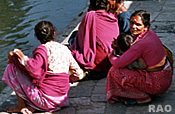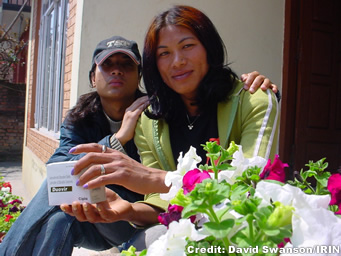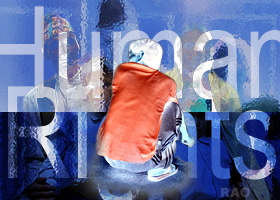 |
Nepal SOCIAL LIFE |
|
 |
Nepal Information |
|
|
 |
|
HIV
hospice for gay and transgender men offers hope |
 |
KATHMANDU,
16 May 2006 (IRIN/PLUSNEWS)
 |
| Devya Gurang, a 24-year old transgender person, outside the Blue Diamond
Society hospice in Kathmandu.
There's
no signboard outside the simple white-washed building at the end of the
road - and neighbours have little idea of who its occupants are. But in
this traditional Hindu society, where open discussion about HIV/AIDS remains
largely taboo, that's not surprising.
Behind
the well-trimmed lawn and flower beds of the two-story building lies Nepal's
only hospice dedicated to caring for men who have sex with men (MSM) infected
with HIV/AIDS, a particularly marginalised group in this impoverished nation
of 28 million. |
|
Funded
by the Elton John Foundation and French NGO Sidaction, the hospice, located
in a working class residential district of the capital Kathmandu, provides
one of the few rays of hope for MSM members living with AIDS.
"I
thought my life was over and even tried to commit suicide," Devya Gurang,
a 24-year-old transgender person from the western city of Pokhara, said,
recalling in vivid detail when she learned that she was infected with the
virus.
Working
the brothel circuit in the Indian film capital of Mumbai and popular for
her effeminate features, she once serviced up to 25 men a day, and conceded
to having unprotected sex on more than one occasion. Not knowing what to
do, and with little money, she returned to Nepal only to find a less than
hospitable welcome.
"People
looked down upon me as a transgender person ... Life was and continues
to be terribly difficult," Devya maintained. "Nobody will give me a job
and the fact that I am HIV positive only makes things worse."
 |
| A
resident of the hospice since it first opened its doors over a year ago,
she now looks upon it as her home, where she assists other transgender
or gay men living with the virus.
Ramnath
Shah, another caretaker at the hospice from Saptari district, close to
the Indian border, agrees. "Life was unbearable for me there," he said,
referring to his staunchly conservative village. "People didn't accept
me," he explained, recalling how he too found sanctuary at the Kathmandu
hospice, where residents receive room and board, along with literacy training
and counselling, as well as antiretroviral (ARV) drugs and periodic group
meetings to provide psychological support. |
|
For
the past five months, Devya has been receiving a daily dosage of ARVs,
including Nevirapine and Duovir, drugs that otherwise would have been out
of reach to her financially, while a doctor comes by once a week to check
on her and other residents' progress.
"I
still have recurrent bouts of diarrhoea and am not feeling very good ?
but at least now I have a chance to get better," she said.
Others,
however, are doing less well. Chinak Tharu, 34, another resident from the
midwestern district of Rupandhi and now physically disabled, laments he
is paying the ultimate price for having unprotected sex. "I'm feeling better
now. Before this I could barely walk," the five-month hospice resident
said.
The
brainchild of Sunil Pant, the Director of Nepal's Blue Diamond Society
(BDS), the hospice, already operating on meagre resources, can mean the
difference between life and death for some.
"The
situation is particularly poor given the double stigmatisation of being
gay and HIV positive in Nepal," the NGO director said, explaining how some
people had actually been driven out of their homes by their families and
communities. "The general understanding of HIV is that people have been
infected by taking part in immoral or dirty behaviour," he said.
According
to the United Nations, there are an estimated 70,000 people between the
ages of 15 and 49 currently living with the virus in the Himalayan kingdom
- with most people not even knowing if they are infected. But Nepal's HIV/AIDS
epidemic is considered to be "concentrated" in nature, meaning a prevalence
rate of less than 1 percent, concentrated among specific vulnerable groups
such as injecting drug users, commercial sex workers (CSW) and their clients,
as well as members of the MSM community.
"These
are the groups that have shown high-risk behaviour and that's usually where
a general epidemic will begin," Aurorita Mendoza, Country Coordinator for
the Joint UN Programme on HIV/AIDS (UNAIDS), warned.
But
while it is difficult to estimate how many HIV cases have actually been
registered within Nepal's largely underground MSM community, it's clear
more needs to be in terms of public awareness. There has yet to be any
comprehensive study of the group, with many people remaining reluctant
to divulge their HIV status, the UNAIDS official said.
Source: IRIN 2006
Copyright
© UN Office for the Coordination of Humanitarian Affairs 2007
[
This report does not necessarily reflect the views of the United Nations]
Integrated
Regional Information Networks (IRIN), part of the UN Office for the Coordination
of Humanitarian Affairs (OCHA). |
 |
 |
 |
Externe
Links |
 |
The
Blue Diamond Society (BDS) is a community-based sexual health, HIV/AIDS,
advocacy services for local networks of sexual minorities in Nepal. |

|
|
The
Blue Diamond Society (BDS) |
 |
|




